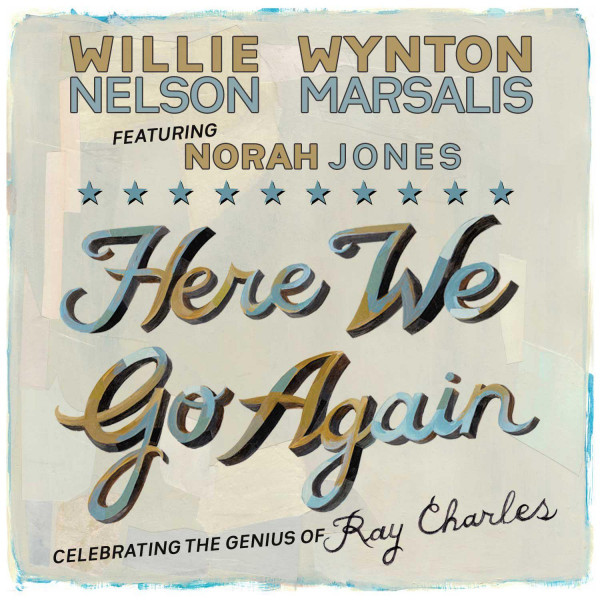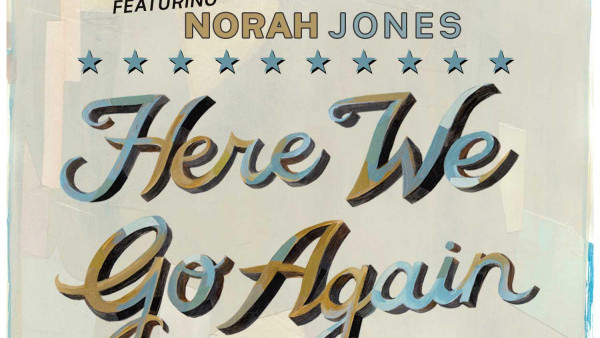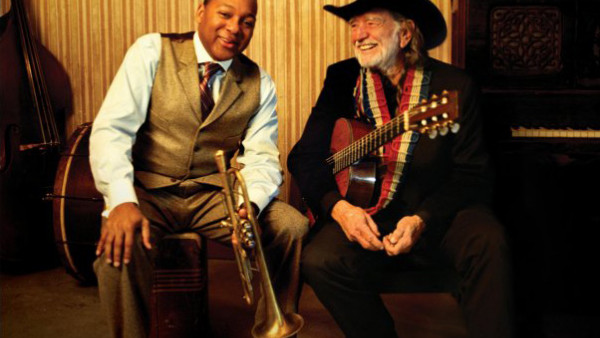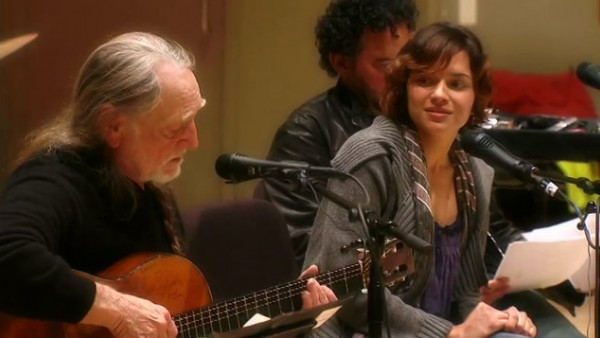Review: Willie Nelson and Wynton Marsalis featuring Norah Jones: Here We Go Again
Not so long ago, the Wynton Marsalis brand in jazz meant fancy-pantsy compositions for orchestra that mixed high-Ellingtonia with a dose of classical pretention — all written to accompany a ballet, perhaps. Whether this music was wonderful or not — and some of it was indeed deeply wonderful and even revelatory — it had neither the fun nor the direct joyousness of the American popular song.
In 2007, however, Marsalis invited a ray of sunshine to share the stage with him at Lincoln Center’s Allen Room. Two Men with the Blues (2008) merged Wynton’s quintet with country artist Willie Nelson and his harmonica player Mickey Raphael, and Blue Note caught the whole thing on tape. Marsalis’s jazz music seemed suddenly to have some down-home soul, some finger-popping fun. It helped Nelson, too — not more lazy go-rounds with his family band on the same old tunes. It was a partnership with real zing to it.
Here We Go Again brings the boys back together in concert, but it adds the considerable vocal style of Norah Jones and, more critically, sets the whole impressive assemblage loose on the repertoire of one of America’s surest musical treasures, Brother Ray Charles. How can you go wrong?
You can’t. And that it what is great about it — and that is what is, just a little, wrong with it.
What’s great is obvious. Marsalis’s band sounds as wondrous as possible on these exquisite tunes. They hip-up the backbeat of “Hallelujah, I Love Her So” with ease and pliant swing. When Marsalis solos, the walking bass kicks in with lope, but the transition back to groove under the harmonica solo is equally seamless. The Latin syncopation of “Unchain My Heart” dances in thrilling little steps. Can the band pull off the Buck Owens tune “Cryin’ Time” as a duet for Nelson and Jones? They can and certainly do, with the lope of a country band and with the tenor saxophone moan of Walter Blanding sounding not at all out of place. “Hit the Road Jack” moans and grooves like no version I’ve heard before, with a tambourine engine that should make most drummers embarrassed by how little they do with a full kit. The freshly composed horn line that frames the solos sounds like a good Jazz Messengers theme. Throughout the proceedings, pianist Dan Nimmer owns the tunes, playing a ton of idiomatically perfect grooves, parts, and licks.
Nelson’s singing continues to be a fountain of relaxed invention, as thoroughly in the line of Louis Armstrong as any regular “jazz singer”. He moves all around the beat, for example, on the blues “Losing Hand”, while Marsalis and the band fill the gaps around his phrasing. “I’m Moving On” is another blues, but one that forces Nelson to stay with the beat. Nevertheless, he eases from word to word with flexible grace. “Hallelujah” finds Nelson pushing ahead of the beat at first, then lagging with a sly bend to his voice. On each of his performances, the real heart of things is how his style contrasts with the tricky Marsalis arrangements.
Norah Jones has no trouble holding her own with either the quintet or Nelson. In fact, if there is one revelation on Here We Go Again, it is how decisive and strong Jones sounds while singing with a truly legitimate jazz group. While her own bands have been nice enough, Jones has never pitted her sinuous single-malt voice against a truly great band. “Come Rain or Come Shine” brings to mind the best of Nancy Wilson’s old records, giving Jones a stylish backing that inspires her to sing more soulfully than I’ve ever heard her. “Makin’ Whoopie” is the other tune entrusted solely to Jones, and she swings it easily but with a healthy dose of bent notes and little tonal pinches. If you’ve never gotten over the Norah Jones overload of “Don’t Know Why”, then this is your antidote.
Of course, other tracks put Nelson and Jones together in duet — another can’t lose proposition. “Cryin’ Time” is silky, and “Hit the Road, Jack” exudes fun, with the band laying extra vocals on the chorus, then the principals singing the classic male and female parts. “Busted” gives parts to Nelson and Marsalis himself, singing like an eager amateur, which just serves to highlight the skill of Nelson and Jones. “What’d I Say” is the classic Charles boogaloo, of course, and it makes room for all three singers, with Jones coming off as the best of the bunch. It’s all a ton of fun.
So what could be wrong with any of this?
The problem is that this record is just exactly what you would think it would be. Nelson breezes through his tunes with cavalier grace, and Jones is a stylish vamp. Marsalis’s quintet delivers with professional mastery, giving every tune what would be expected. But the whole never really rises above the sum of its parts, and no one ever tries to teach us something new about these tunes. When Brother Ray sang a country song, he seemed to inject it with a new life, a new perspective. When these all-stars tackle Ray’s canon, they remind us of Ray more than anyone or anything else.
Not that hearing these voices on great tunes doesn’t thrill. It does. And knowing that each song has gotten a special bit of planning from Marsalis — with fresh horn lines delivered with actual soul — is the best part of all. But the problem is that this concert and subsequent recording was a Can’t Miss from the start, a guaranteed good time, a lead-pipe lock even as it was being drawn up on a Lincoln Center chalkboard. What’s missing is some element of risk or sacrifice.
On the first Willie/Wynton record, you sensed that this collaboration was a reach for both parties. Possible failure or at least discomfort was around every corner, with Marsalis tightening and pushing Nelson’s lackadaisical game and Nelson bringing Marsalis’s precision into easy relief. This time out, everyone has mellowed into some regularity. It’s a working band now, at least between Nelson, Raphael, and the Marsalis group, and some tedium is suggested. Only when Jones lets loose does a trace of edge emerge, and she gets — at least from my point of new — too little to do here.
As enjoyable as Here We Go Again most surely is, its provenance as a one-off concert and tribute to Ray Charles is in evidence. The audience had a great time, and so will you in listening to it. But it is also a recording that makes you realize that Norah Jones, Willie Nelson, and Wynton Marsalis have more in them (collectively, but also each on their own) than this disc shows. Jones should challenge herself to make a real jazz record with a great band. Nelson should push further out of his comfort zone to show how universal his art can be.
And Wynton Marsalis, who makes so much music in so many contexts, could stand to realize that his “fun” side and his serious side don’t have to be quite so Jekyll and Hyde. Some of his finest playing has been on these joyous records. How about more of this, but with your own band, Maestro? In American art, a good time is often the most profound thing there is. Here We Go Again hints at this possibility, but pulls up just a little short.
by Will Layman
Source: PopMatters




